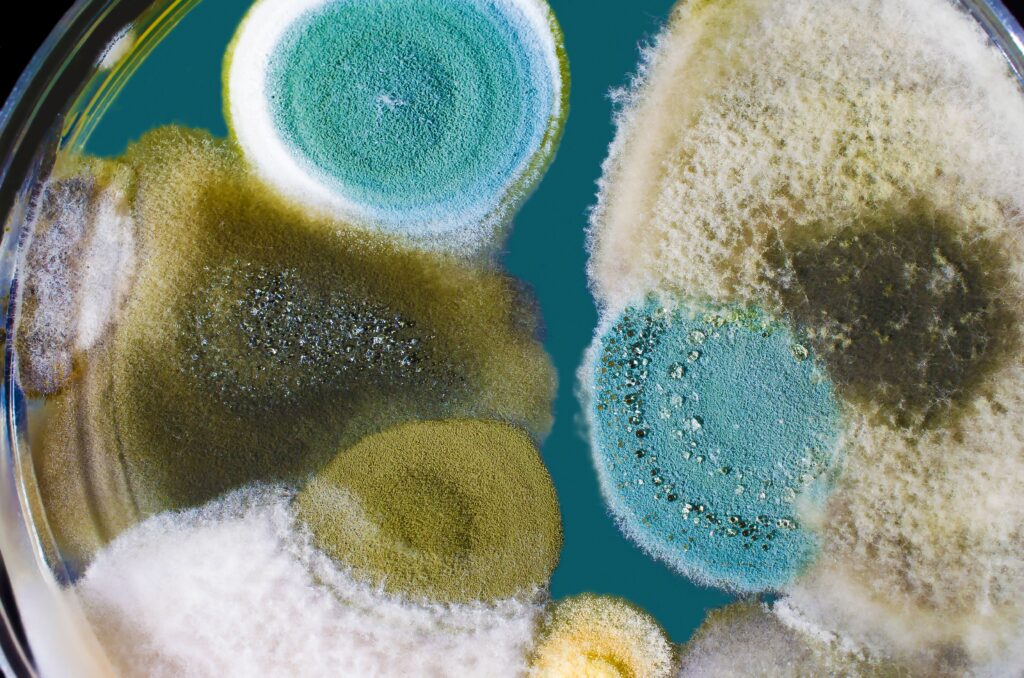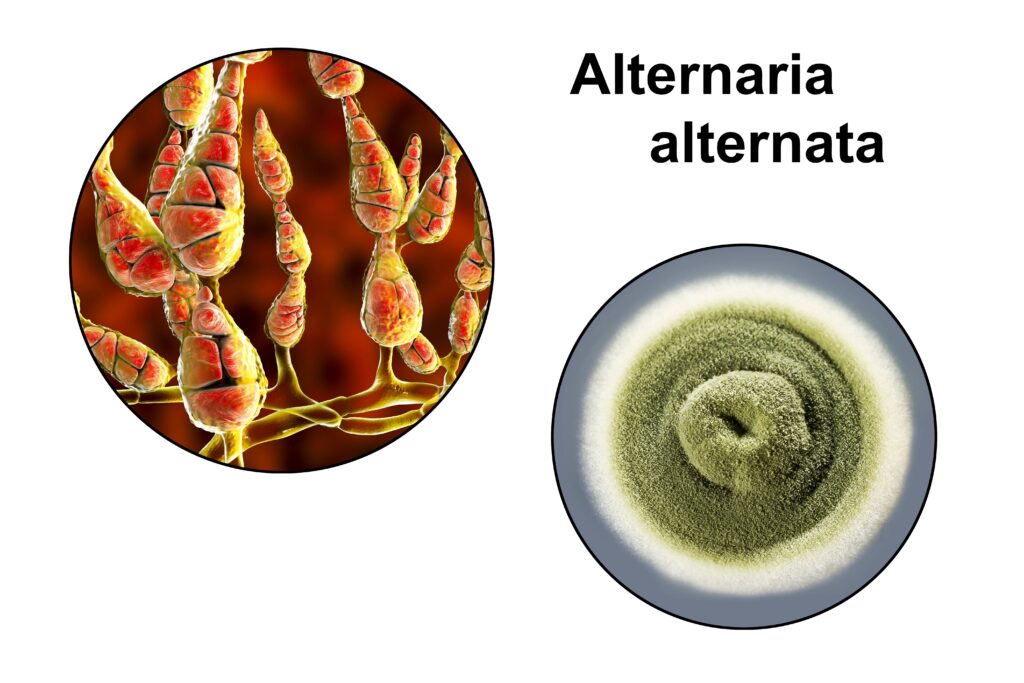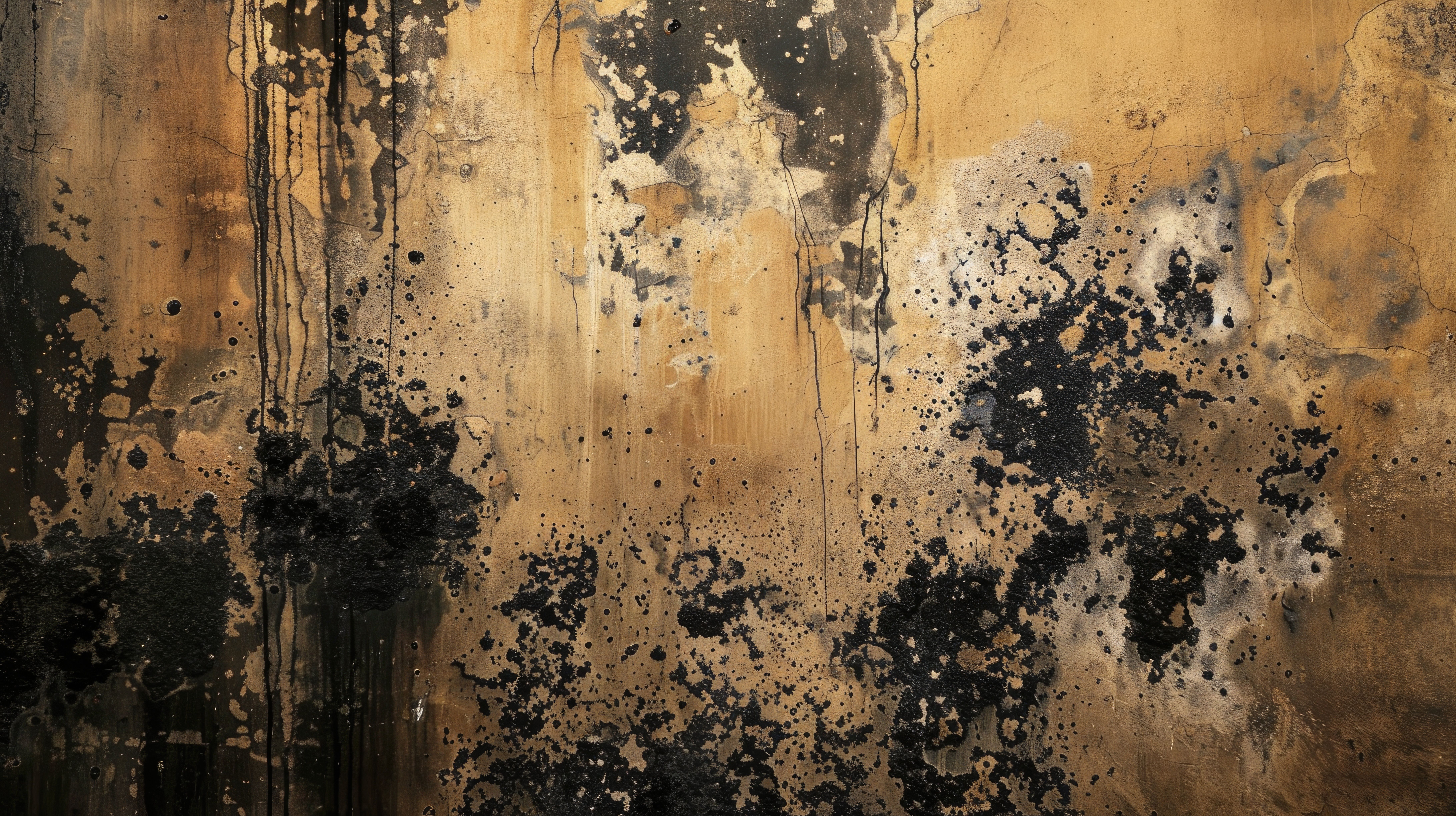When people think about toxic mold, names like Stachybotrys chartarum—commonly referred to as “black mold”—typically top the list. But there’s another mold lurking in water-damaged environments that poses just as serious a health threat: Alternaria.
At IndoorDoctor, we’ve found Alternaria to be a highly aggressive and pathogenic mold species, one that’s not as well known but just as hazardous as its more infamous counterparts. In our extensive fieldwork, we’ve encountered clients suffering from recurring nasal infections, respiratory distress, and worsening allergies, with one common factor—Alternaria contamination.
In this article, we explore what makes Alternaria such a threat, how it compares to other toxigenic molds, the health risks associated with it, and most importantly, how to detect and eliminate it safely.
What is Alternaria?
Alternaria is a genus of ascomycete fungi, comprising over 300 species. While some species are found in soil and plants, certain strains—like Alternaria alternata—can colonize indoor environments, particularly after water damage. It is frequently found on damp drywall, wallpaper, carpets, window frames, and insulation. Indoors, its presence typically signals a moisture issue or previous flooding.
What’s alarming about Alternaria is how easily it becomes airborne. Its spores are small, light, and travel far, making it easy to inhale and hard to avoid once released into an indoor environment.
🦠 Did You Know? Alternaria spores are some of the most common allergens detected in outdoor air samples—but their presence indoors usually means water damage has occurred.

Alternaria vs. Black Mold (Stachybotrys)
We often equate Alternaria to Stachybotrys in terms of severity. While Stachybotrys thrives on chronically wet cellulose materials and releases mycotoxins, Alternaria is more insidious—it can grow under similar conditions but spreads more easily, often being overlooked until symptoms emerge.
| Feature | Alternaria | Stachybotrys |
|---|---|---|
| Growth Conditions | Damp drywall, insulation, carpet | Wet drywall, cellulose |
| Common Locations | Window sills, HVAC systems, carpeting | Behind walls, flooded basements |
| Spore Dispersal | Light, easily airborne | Heavy, limited air dispersal |
| Health Risk Level | High | High |
| Associated Symptoms | Nasal infections, asthma, sinusitis, hypersensitivity | Fatigue, headaches, respiratory inflammation |
In short, Alternaria is the “stealthy cousin” of black mold—often more mobile, more common in certain climates, and capable of causing severe health problems when inhaled regularly.
Why Alternaria is More Dangerous Than You Think
1. Airborne and Aggressive
Unlike Stachybotrys, whose heavier spores are often localized to water-damaged materials, Alternaria spores are lightweight and highly dispersible. They become airborne through HVAC systems, drafts, or even foot traffic on contaminated carpet.
In IndoorDoctor’s field inspections, we’ve encountered entire homes with elevated airborne Alternaria levels despite no visible mold. That’s because Alternaria doesn’t always produce a strong odor and often grows behind walls, in insulation, or HVAC ductwork—areas people seldom check.
2. Linked to Chronic Health Conditions
Alternaria is particularly notorious for triggering respiratory infections and allergic reactions. Its spores contain potent allergens and are highly immunogenic.
At IndoorDoctor, we’ve seen firsthand how exposure often leads to:
- Chronic nasal infections and sinusitis
- Persistent sneezing, wheezing, and coughing
- Aggravated asthma symptoms
- Hypersensitivity pneumonitis
- Irritant-induced vocal cord dysfunction
A 2006 study in the Journal of Allergy and Clinical Immunology found that sensitivity to Alternaria spores is a strong risk factor for severe asthma attacks—especially in children and immunocompromised individuals【1】.
🧬 Scientific Insight: Alternaria alternata produces over 70 different secondary metabolites, including alternariol and tenuazonic acid—known mycotoxins with documented cytotoxic and genotoxic properties【2】.
Water Damage and Alternaria
IndoorDoctor’s inspection protocols always prioritize moisture tracking—because water damage is the starting point for nearly all problematic mold growth. Alternaria doesn’t just appear without cause; its presence strongly suggests prior or ongoing water intrusion.
Common triggers for Alternaria growth include:
- Leaky windows or roofs
- Improperly sealed bathrooms or kitchens
- HVAC condensate leaks
- Basement humidity over 60%
- Flooding that was never fully remediated
📸 Case Study Highlight: One family we worked with in coastal Massachusetts had recurrent sinus infections despite a visually clean home. Our IndoorDoctor On-Demand sampling revealed sky-high Alternaria spore levels in the HVAC return duct. Moisture tracing found a slow leak from a second-floor bathroom that had never been detected.

The Hidden Health Risks: Nasal Infections and Beyond
The most common issue we see among clients with Alternaria exposure is persistent nasal and sinus infections. These often start as “seasonal allergies” but evolve into chronic conditions requiring antibiotics or even sinus surgery.
Health Symptoms Attributed to Alternaria Exposure:
| System Affected | Symptoms |
|---|---|
| Respiratory | Sneezing, wheezing, coughing, asthma |
| Sinus/Nasal | Infections, congestion, sinusitis |
| Eyes | Redness, itching, tearing |
| Skin | Rashes, itching, hives |
| Neurological (in rare cases) | Headaches, brain fog |
| Immune | Hypersensitivity reactions, increased inflammation |
🛑 Important: For individuals with mold-related illness (CIRS), Lyme disease, or asthma, Alternaria exposure can significantly worsen symptoms—even when mold is not visible.
Why Alternaria Testing is Critical
Given Alternaria’s dispersal behavior and health effects, the only way to understand your risk is through professional-grade testing. DIY kits from big-box stores may test surface mold but rarely offer insights into airborne spore levels or hidden mold reservoirs.
What You Need:
- Spore Trap Air Sampling: Determines current airborne levels.
- ERMI/HERTSMI Testing: Detects mold DNA (we recommend these as supplemental).
- Visual and Moisture Inspection: To find the source and moisture route.
- HVAC Inspection: We often find Alternaria colonies growing inside ducts or coils.
🧪 IndoorDoctor’s On-Demand Air Quality Testing service is designed for this exact need. Within 24–48 hours, you can have a professional test kit delivered to your door with easy-to-follow instructions, lab analysis, and expert interpretation.
Eliminating Alternaria: What to Do If It’s Found
If Alternaria is discovered, proper remediation is essential. Unlike cosmetic mold cleanup, this is not a “just wipe it off” situation. Because of its health impacts, you must treat Alternaria as a hazardous contaminant.
Key Remediation Steps:
- Identify and stop the moisture source.
- Seal off affected areas.
- HEPA vacuum and negative air containment.
- Remove affected materials (drywall, insulation, carpets).
- Clean air ducts with anti-fungal treatments.
- Post-remediation verification with new testing.
💡 Tip: Avoid bleach! Bleach doesn’t penetrate porous materials and may actually worsen mold release. Use mold-specific cleaners and hire certified professionals.
Alternaria Prevention: Don’t Let Alternaria Come Back
Once you’ve remediated Alternaria, your next goal is to prevent regrowth. This means controlling moisture, increasing airflow, and filtering your air.
Prevention Checklist:
- Keep indoor humidity below 50%
- Use HEPA filters in HVAC systems
- Install dehumidifiers in basements and crawlspaces
- Inspect attics and windows seasonally for leaks
- Ventilate bathrooms and kitchens properly
🧭 IndoorDoctor Pro Tip: Our On-Demand Testing includes detailed guidance on humidity levels, HVAC setup, and mold prevention. We’re not just testing—we’re equipping you with a prevention strategy.
Alternaria: A Mold Deserving More Attention
At IndoorDoctor, we consider Alternaria one of the most under-recognized but dangerous indoor molds. It doesn’t always make headlines like “black mold,” but it’s just as toxic—and arguably harder to detect due to its airborne nature and lack of strong odor.
If you’re experiencing chronic sinus issues, persistent fatigue, or live in a previously flooded or humid home, you could be unknowingly inhaling Alternaria spores.
Through advanced testing, expert inspection, and informed remediation, we help our clients restore healthy indoor environments and breathe freely again.
Citations
- Bush, R. K., & Prochnau, J. J. (2004). Alternaria-induced asthma. Journal of Allergy and Clinical Immunology, 113(2), 227-234. https://doi.org/10.1016/j.jaci.2003.11.017
- Logrieco, A., Moretti, A., Solfrizzo, M. (2009). Alternaria toxins and plant diseases: an overview of origin, occurrence and risks. World Mycotoxin Journal, 2(2), 129–140. https://doi.org/10.3920/WMJ2008.1046
- Simon-Nobbe, B., Denk, U., Poll, V., Rid, R., & Breitenbach, M. (2008). The spectrum of fungal allergy. International Archives of Allergy and Immunology, 145(1), 58–86. https://doi.org/10.1159/000107578
- IndoorDoctor. (2025). On-Demand Air Quality Testing.
- Kurup, V. P., Shen, H. D., & Banerjee, B. (2000). Respiratory fungal allergy. Microbes and Infection, 2(9), 1101–1110. https://doi.org/10.1016/S1286-4579(00)01282-8




